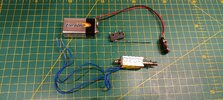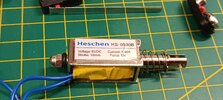Hi All. This is my first time here. and can i just say thanks for having me.
i am a tinkerer in my spare time. I do IT for a living and am a big gamer and 3d printer.
I am designing pistol grips for my VR headset. and i am wanting to re-produce recoil on the gun grips.
i have a nice little spring loaded solinoid that gived a good feeling then supplied with an sharp on off of power.
But i would like a simple circuit so that then you press the button it supplies power to the servo for lets say .2 of a second. then cuts the power. even if you are still holding the button down.
Can anyone help with the smallest simplest design i could possably use? also my electronics knowledge is limited at best. but i can solder and i am not stupic
i am a tinkerer in my spare time. I do IT for a living and am a big gamer and 3d printer.
I am designing pistol grips for my VR headset. and i am wanting to re-produce recoil on the gun grips.
i have a nice little spring loaded solinoid that gived a good feeling then supplied with an sharp on off of power.
But i would like a simple circuit so that then you press the button it supplies power to the servo for lets say .2 of a second. then cuts the power. even if you are still holding the button down.
Can anyone help with the smallest simplest design i could possably use? also my electronics knowledge is limited at best. but i can solder and i am not stupic


